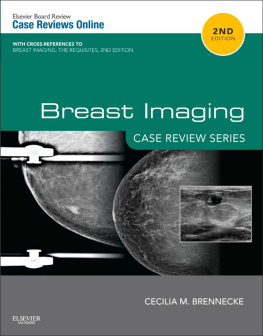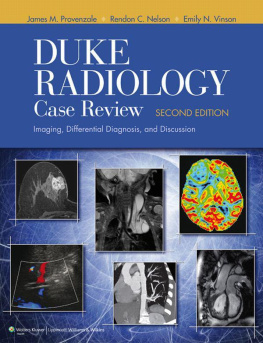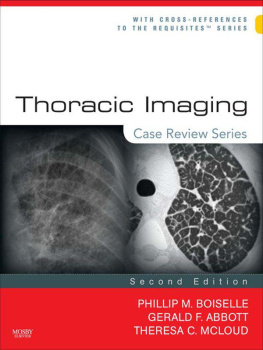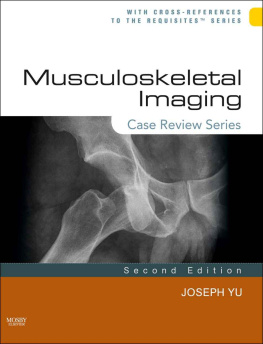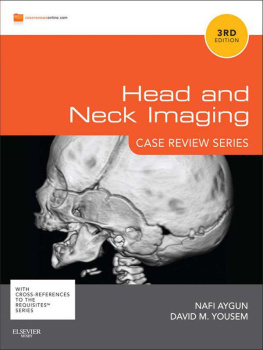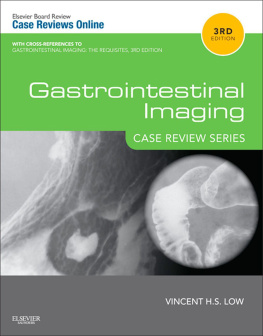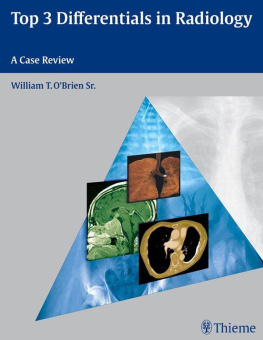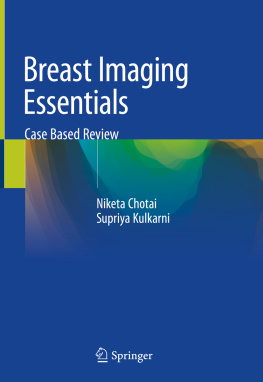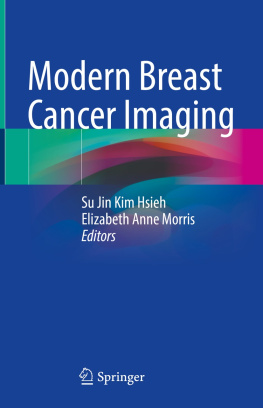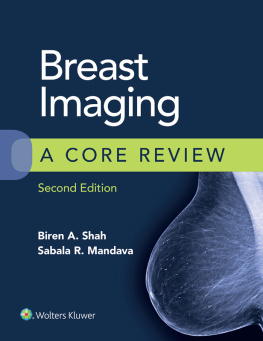Series Editor
David M. Yousem, MD, MBA
Professor of Radiology
Director of Neuroradiology
Russell H. Morgan Department of Radiology and Radiological Science
The Johns Hopkins Medical Institutions
Baltimore, Maryland
Other Volumes in the CASE REVIEW Series
Brain Imaging, Second Edition
Cardiac Imaging
Duke Review of MRI Principles
Emergency Radiology
General and Vascular Ultrasound, Second Edition
Gastrointestinal Imaging, Third Edition
Genitourinary Imaging, Second Edition
Musculoskeletal Imaging, Second Edition
Nuclear Medicine, Second Edition
Obstetric and Gynecologic Ultrasound, Second Edition
Pediatric Imaging, Second Edition
Spine Imaging, Second Edition
Thoracic Imaging, Second Edition
Vascular and Interventional Imaging
Breast Imaging
CASE REVIEW
SECOND EDITION
Cecilia M. Brennecke, MD
Medical Director
Johns Hopkins at Green Spring
Baltimore, Maryland
CASE REVIEW SERIES


1600 John F. Kennedy Blvd.
Ste 1800
Philadelphia, PA 191032899
BREAST IMAGING: CASE REVIEW, SECOND EDITION
ISBN: 978-0-323-08722-3
Copyright 2012 by Saunders, an imprint of Elsevier Inc.
Copyright 2006 by Mosby, Inc., an affiliate of Elsevier Inc.
No part of this publication may be reproduced or transmitted in any form or by any means, electronic or mechanical, including photocopying, recording, or any information storage and retrieval system, without permission in writing from the publisher. Details on how to seek permission, further information about the Publishers permissions policies and our arrangements with organizations such as the Copyright Clearance Center and the Copyright Licensing Agency, can be found at our website: www.elsevier.com/permissions.
This book and the individual contributions contained in it are protected under copyright by the Publisher (other than as may be noted herein).
Notices
Knowledge and best practice in this field are constantly changing. As new research and experience broaden our understanding, changes in research methods, professional practices, or medical treatment may become necessary.
Practitioners and researchers must always rely on their own experience and knowledge in evaluating and using any information, methods, compounds, or experiments described herein. In using such information or methods they should be mindful of their own safety and the safety of others, including parties for whom they have a professional responsibility.
With respect to any drug or pharmaceutical products identified, readers are advised to check the most current information provided (i) on procedures featured or (ii) by the manufacturer of each product to be administered, to verify the recommended dose or formula, the method and duration of administration, and contraindications. It is the responsibility of practitioners, relying on their own experience and knowledge of their patients, to make diagnoses, to determine dosages and the best treatment for each individual patient, and to take all appropriate safety precautions.
To the fullest extent of the law, neither the Publisher nor the authors, contributors, or editors, assume any liability for any injury and/or damage to persons or property as a matter of products liability, negligence or otherwise, or from any use or operation of any methods, products, instructions, or ideas contained in the material herein.
International Standard Book Number
978-0-323-08722-3
Content Strategist: Don Scholz
Content Development Specialist: Gina Donato
Publishing Services Manager: Patricia Tannian
Design Direction: Steven Stave

To my mother, Patti R. Brennecke, and
in memory of my father,
Charles N. Brennecke
SERIES FOREWORD
I have been very gratified by the popularity and positive feedback that the authors of the Case Review series have received on the publication of the first and second editions of their volumes. Reviews in journals and word-of-mouth comments have been uniformly favorable. The authors have done an outstanding job in filling the niche of an affordable, easy-to-read, case-based learning tool that supplements the material in The Requisites series. I have been told by residents, fellows, and practicing radiologists that the Case Review series books are the ideal means for studying for oral board examinations and subspecialty certification tests.
Although some students learn best in a noninteractive study book mode, others need the anxiety or excitement of being quizzed. The selected format for the Case Review series (which consists of showing a few images needed to construct a differential diagnosis and then asking a few clinical and imaging questions) was designed to simulate the board examination experience. The only difference is that the Case Review books provide the correct answer and immediate feedback. The limit and range of the readers knowledge are tested through scaled cases ranging from relatively easy to very hard. The Case Review series also offers a brief discussion of each case, a link back to the pertinent The Requisites volume, and up-to-date references from the literature.
Because of the popularity of the series, we have been rolling out the second and third editions of the Case Review series volumes. The expectation is that these editions will bring the content up to the current knowledge limits of the field, introduce new modalities and new techniques, and provide new and even more graphic examples of pathology. To adjust to the upcoming change from an oral board examination to a computer-based one, the Case Review series has changed. We have moved to an even more engaging live platform through the use of the Internet. The questions have been reframed into multiple-choice format, the links are dynamic to online references, and feedback is interactive with correct and incorrect answers. Please see the website www.casereviewsonline.com to see how the Case Review series has evolved to prepare trainees for the board examinations and practitioners for reading specialty cases. Personally, I am very excited about the future. Join us.
David M. Yousem, MD, MBA
PREFACE
This second edition of Case Reviews: Breast Imaging is an exciting new volume. In the first edition, cases were illustrated with film-screen mammography. In this edition, nearly all cases are digital. This reflects the evolution in mammography to the digital examination. The digital format makes subtle changes of breast disease easier to find on the images compared with film. I hope that you agree and that you enjoy your travels and discovery through the exciting world of breast imaging.
Acknowledgments: I thank the series editor and my Johns Hopkins colleague, Dr. David M. Yousem, and my Elsevier editor, Gina Donato. You always inspire me to do a little better.
I also thank my colleagues at Johns Hopkins Imaging at Green Spring Station: Drs. Susan Harvey, Lisa Mullen, and Bruce Copeland, all superb breast radiologists, and Dr. Fouad Gellad, who is not a breast radiologist but is forgiven for that lapse in judgment. The cases in this book reflect our work at the breast center at Johns Hopkins at Green Spring. Dr. Evelyn May is my colleague at our sister institution, The Johns Hopkins Hospital. She provided images and wrote several of the cases in this book. I thank Evelyn for her expertise.

